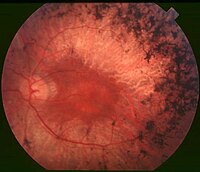
Photo from wikipedia
Myopia, commonly referred to as nearsightedness, is one of the most common causes of visual disability throughout the world. It affects more people worldwide than any other chronic visual impairment… Click to show full abstract
Myopia, commonly referred to as nearsightedness, is one of the most common causes of visual disability throughout the world. It affects more people worldwide than any other chronic visual impairment condition. Although the prevalence varies among various ethnic groups, the incidence of myopia is increasing in all populations across globe. Thus, it is considered a pressing public health problem. Both genetics and environment play a role in development of myopia. To elucidate the epigenetic mechanism(s) underlying the pathophysiology of high-myopia, we conducted methylation profiling in 18 cases and 18 matched controls (aged 4–12 years), using Illumina MethylationEPIC BeadChips array. The degree of myopia was variable among subjects, ranging from −6 to −15D. We identified 1541 hypermethylated CpGs, representing 1745 genes (2.0-fold or higher) (false discovery rate (FDR) p ≤ 0.05), multiple CpGs were p < 5 × 10−8 with a receiver operating characteristic area under the curve (ROC-AUC) ≥ 0.75 in high-myopia subjects compared to controls. Among these, 48 CpGs had excellent correlation (AUC ≥ 0.90). Herein, we present the first genome-wide DNA methylation analysis in a unique high-myopia cohort, showing extensive and discrete methylation changes relative to controls. The genes we identified hold significant potential as targets for novel therapeutic intervention either alone, or in combination.
Journal Title: Scientific Reports
Year Published: 2019
Link to full text (if available)
Share on Social Media: Sign Up to like & get
recommendations!